Hansen's Sunday Notebook: Steve Kerr a shoo-in for Basketball Hall of Fame ... someday
- Updated
Star sports columnist Greg Hansen offers his opinion on recent sports news.
- Greg Hansen
I flew to Springfield, Massachusetts, twice in the summer of 2002 to visit the Naismith Basketball Hall of Fame. The occasion: Lute Olson was part of the Class of 2002.
Olson was 68 and a year removed from his fifth Final Four season. He was established behind John Wooden as the No. 2 coach in Pac-12 history and as I examined all of the displays at the Hall of Fame, I thought: what took so long?
The answer was simple: No one in all of college basketball had nominated Olson until UA athletic director Jim Livengood did so a year earlier.
Those previously inducted from western basketball precincts included BYU’s Stan Watts, Washington’s Marv Harshman, Oregon State’s Ralph Miller and Slats Gill and Utah’s Jack Gardner. All were skilled and successful coaches, but they remained mostly regional names. Only Gardner had been to a Final Four.
In a sense, by 2002, Olson was over-qualified.
And that’s why I strongly think Steve Kerr has already done more than enough to secure his election into basketball’s most cherished Hall of Fame. If he retired today, he’s in.
The Naismith Basketball Hall of Fame inducts coaches, players and contributors. Kerr’s résumé touches all variables: He was Arizona’s All-America point guard at the 1988 Final Four; he played important roles on five NBA championship teams; he has coached the Golden State Warriors to two NBA championships; he was college basketball’s lead analyst for the NCAA Tournament for seven years; he was general manager of the Phoenix Suns; he was a rotation player for America’s 1986 World Championship gold medal team.
The clincher (as if it’s needed): The style of play Kerr introduced at Golden State – run, gun, fun, fun, fun – has revolutionized pro basketball.
There’s no rush to put Kerr on the Hall of Fame ballot. He’s only 51. But as I run my thumb down the list of those enshrined — George Raveling, Dennis Rodman, Bob Hurley Sr., — I get the feeling that Kerr, like his mentor Olson, will be a first-ballot inductee someday soon.
- Greg Hansen
The ongoing U.S. Open at Erin Hills, Wisconsin, has introduced two names to the golf world: Dana Fry and Shane Bacon.
Fry, who has become a prominent golf architect and is one of three men to design Erin Hills, was part of Arizona coach Rick LaRose’s 1980-83 golf teams. Fry was a walk-on from Kansas City, Missouri, who made the Wildcat squad by shooting a 64 in a one-day, all-comers tryout at Randolph North in 1980.
Upon leaving the UA, Fry got his foot in the golf-design business by helping to shape the bunkers at the Ventana Canyon Golf Course for the esteemed Tom Fazio in 1984.
Fry remains in contact with LaRose – they spent time together at the annual PGA Show in Orlando, Florida, in January – and he invited Crooked Tree Golf Course pro Rich Mueller to Erin Hills early last week.
Bacon is a UA grad and former Arizona Daily Wildcat reporter who is part of Fox Sports’ new broadcast team at the U.S. Open. Among other things, he conducts post-round interviews, at which he is very good. Bacon used to be the caddie for the late Erica Blasberg, a 2003 and 2004 Arizona All-American.
Fry is not the first UA golfer to design a U.S. Open course. The first was Bruce Charlton, Class of ’81.
Charlton was the lead designer at Chambers Bay in Tacoma, Washington, site of the 2015 U.S. Open. He graduated with honors from the landscape architecture program at Arizona and was hired by the great Robert Trent Jones Jr. and has been working with Jones for 36 years.
Charlton, the president and chief design officer for Robert Trent Jones, was part of the design team at Arizona National Golf Course near Mount Lemmon Highway. He told me he will not only be at the U.S. Open this weekend to spend time with his old Wildcat colleague, but will “sport some Wildcat gear.”
- Greg Hansen
Arizona senior Sage Watson became the 12th UA woman to win an NCAA outdoor track and field championship last week. She won the 400 hurdles in Eugene, Oregon, and becomes, with ex-Wildcat All-American Georgeanne Moline, one of the favorites to reach the 400-meter hurdles at the 2020 Olympics. It’s impressive to research the UA’s list of women’s NCAA champions: Meg Ritchie, Carla Garrett, Amy Skieresz, Tanya Hughes, Brianna Glenn and Brigetta Barrett all won multiple national titles. Barrett, a silver medalist high-jumper at the 2012 London Olympics and three-time NCAA outdoor champ, retired in 2016 to concentrate on a singing and acting career but returned to high jumping in April. She is 26.
- Greg Hansen
Cienega High senior quarterback Jamarye Joiner has committed to enroll at Arizona in 2018. But last week he attended the ASU Maroon and Gold 7-on-7 passing camp – which his talented Bobcat teammates won – and was offered a scholarship by the Sun Devils. Joiner then posted a twitter photograph wearing ASU gear and flashing the Sun Devils’ pitchfork sign. I get that this is the 21st century and college sports recruiting commitments are often meaningless, but from someone who grew up in an earlier generation – remember the “your word is your bond” pledge? – the flipping and flopping will never sit right. Joiner also got an offer from Pac-12 champion Washington and visited Notre Dame.
- Greg Hansen
The Arizona Coyotes did the right thing by agreeing to stage an NHL preseason game at Tucson Arena against the Anaheim Ducks. The Tucson Roadrunners began their inaugural season, 2016, with limited promotion and marketing time and finished 31st of 32 teams in the American Hockey League in attendance, at just over 4,000 per game. The NHL game, staged on Monday, Sept. 25, should spread the message in Tucson better than any series of promotions.
- Greg Hansen
One regrettable omission from my ongoing Top 10 of Everything in Tucson sports series: Vicky Maes, who is probably the top women’s tennis player in UA history, was not part of my list of former UA athletes who became UA head coaches. Big goof. Maes spends the summer as a club pro near Ludington, Michigan.
- Greg Hansen
Big Ten commissioner Jim Delaney last week spoke for all college basketball fans by saying his conference is investigating an expansion to 20 league games. Big Ten teams currently play 18 league games – as do the Pac-12, ACC, SEC and Big 12 – which is a sometimes faulty way to determine conference championships. Arizona, for example, will not play at UCLA and USC in 2016-17. That means the UA and others fill the scheduling blanks with schools like CS Bakersfield and Grand Canyon. Delaney told reporters the jump from 18 to 20 conference games “would certainly be favorable to bring more high-profile games to college basketball earlier in the season.” Currently, the MAAC, a league with Iona, Quinnipiac and Niagara, is the only Division I conference to play a 20-game league schedule.
- Greg Hansen
Catalina Foothills outfielder/pitcher Luis Gonzalez and Cienega outfielder/pitcher Andre Jackson were two of Tucson’s leading high school baseball players from 2013-14. Gonzalez went to New Mexico, Jackson to Utah. Both were selected in the MLB draft last week. Gonzalez went No. 87 overall to the White Sox, a spot that pays a bonus of roughly $650,000, and Jackson, who missed the 2017 season at Utah after undergoing Tommy John arm surgery, was taken No. 370 overall by the Dodgers. Jackson could sign for about $100,000, although if the Dodgers like him enough they could offer a maximum of $389,000, which is subject to a fine by MLB.
- Greg Hansen
Alex Robles, a Tucson High grad who often played against Gonzalez and Jackson, was drafted in the 30th round by the Minnesota Twins. Robles completed his remarkable career at Austin Peay by hitting a grand slam in his last at-bat. He was a two-time All-Ohio Valley Conference selection who hit a team-high .347 with 10 homers this year. He also won six games as a starting pitcher.
- Greg Hansen
Even though UA sophomore catcher Cesar Salazar wasn’t selected in the MLB draft, I fully believe he’ll play in the big leagues one day. Salazar is a defensive whiz and a clutch hitter. Beyond that, he’s the type of teammate you want in your dugout. Salazar had the game-winning hit against Mississippi State in last year’s Super Regionals. Another edge Salazar has over many catching prospects is that he’s a left-handed hitter.
- Greg Hansen
The NCAA blew it last week when it signed a contract to stage the 2020, 2021 and 2022 NCAA men’s and women’s golf championships at the Grayhawk Golf Club in Scottsdale. Did anyone check the history of weather in the final week of May and first week of June in Scottsdale? It’s neither player-friendly nor fan-friendly. Worse, hundreds of volunteers required to operate the NCAA finals will spend eight hours a day in heat near 100 degrees. The NCAA held the 1972 NCAA men’s golf championships at Tucson National and the temperature on the first day was 105 degrees. The Star published a photograph of eventual winner Ben Crenshaw of Texas with future PGA Tour star Lanny Wadkins with the caption “When You’re Hot, You’re Hot.” Golf Channel and the NCAA struck gold when it changed the format of the championship, changing it to a more viewer-friendly team match play format. I suspect the Grayhawk Golf Club paid a small fortune to acquire the rights to be host but it will be an uncomfortable week for all involved.
- Greg Hansen
College football coaches aren’t the only coaches to join other programs in summer recruiting camps. Arizona and BYU joined for a weekend at Arizona Stadium recently. UA volleyball coach Dave Rubio was in Sandpoint, Idaho, last week at a recruiting camp in conjunction with Eastern Washington University. Rubio’s recruiting work landed an incoming class ranked as high as No. 12 nationally, with the nation’s Nos. 27, 63 and 86 prospects. The Pac-12 gave Rubio another strange road schedule this week, but rather than a Thursday-Sunday split in the state of Washington, it gave Arizona a back-to-back trip at Colorado and Utah on Nov. 17-18, which is rare.
- Greg Hansen
Arizona State announced last week it will not extend football coach Todd Graham’s contract through 2021, which, when a team is winning, is a routine rollover maneuver.
But Graham went 5-7 last year, losing six of his last seven with a defense that yielded 56 points to a bungling Arizona team. Most analysts pick the Sun Devils to battle Arizona for last place in the Pac-12 South.
Arizona has made no announcement on Rich Rodriguez’s contract. It has not been rolled over to 2021, either.
Both schools attempted to trigger some public support last week. Arizona transmitted a photo-shopped twitter image of tailback J.J. Taylor sitting in an tiny chair next to oversized lineman Jacob Alsadek with the theme “Run Game.” After a 3-9 season, the cute summer videos of previous years – a James Bond-themed video and a tough guys at Old Tucson setup – don’t work.
Just play.
ASU last week promoted its new big screen video board at Sun Devil Stadium. It is 5,400 square feet, which is a few yards bigger than the one Greg Byrne installed at Arizona Stadium five years ago.
“Having one of the Top 10 largest video boards in collegiate athletics will set us apart,” said Sun Devil athletics COO Rocky Harris.
Well, probably not. Almost every Pac-12 stadium now has a video screen of similar size and function.
More like this...
- Greg Hansen
I flew to Springfield, Massachusetts, twice in the summer of 2002 to visit the Naismith Basketball Hall of Fame. The occasion: Lute Olson was part of the Class of 2002.
Olson was 68 and a year removed from his fifth Final Four season. He was established behind John Wooden as the No. 2 coach in Pac-12 history and as I examined all of the displays at the Hall of Fame, I thought: what took so long?
The answer was simple: No one in all of college basketball had nominated Olson until UA athletic director Jim Livengood did so a year earlier.
Those previously inducted from western basketball precincts included BYU’s Stan Watts, Washington’s Marv Harshman, Oregon State’s Ralph Miller and Slats Gill and Utah’s Jack Gardner. All were skilled and successful coaches, but they remained mostly regional names. Only Gardner had been to a Final Four.
In a sense, by 2002, Olson was over-qualified.
And that’s why I strongly think Steve Kerr has already done more than enough to secure his election into basketball’s most cherished Hall of Fame. If he retired today, he’s in.
The Naismith Basketball Hall of Fame inducts coaches, players and contributors. Kerr’s résumé touches all variables: He was Arizona’s All-America point guard at the 1988 Final Four; he played important roles on five NBA championship teams; he has coached the Golden State Warriors to two NBA championships; he was college basketball’s lead analyst for the NCAA Tournament for seven years; he was general manager of the Phoenix Suns; he was a rotation player for America’s 1986 World Championship gold medal team.
The clincher (as if it’s needed): The style of play Kerr introduced at Golden State – run, gun, fun, fun, fun – has revolutionized pro basketball.
There’s no rush to put Kerr on the Hall of Fame ballot. He’s only 51. But as I run my thumb down the list of those enshrined — George Raveling, Dennis Rodman, Bob Hurley Sr., — I get the feeling that Kerr, like his mentor Olson, will be a first-ballot inductee someday soon.
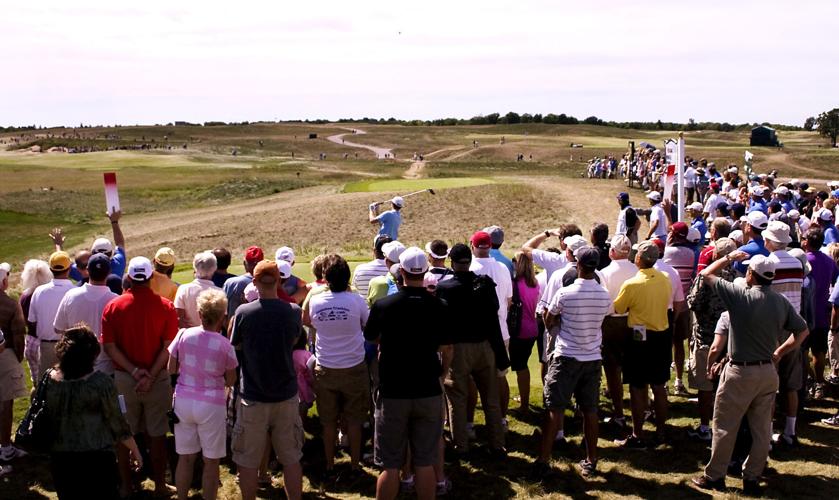
- Greg Hansen
The ongoing U.S. Open at Erin Hills, Wisconsin, has introduced two names to the golf world: Dana Fry and Shane Bacon.
Fry, who has become a prominent golf architect and is one of three men to design Erin Hills, was part of Arizona coach Rick LaRose’s 1980-83 golf teams. Fry was a walk-on from Kansas City, Missouri, who made the Wildcat squad by shooting a 64 in a one-day, all-comers tryout at Randolph North in 1980.
Upon leaving the UA, Fry got his foot in the golf-design business by helping to shape the bunkers at the Ventana Canyon Golf Course for the esteemed Tom Fazio in 1984.
Fry remains in contact with LaRose – they spent time together at the annual PGA Show in Orlando, Florida, in January – and he invited Crooked Tree Golf Course pro Rich Mueller to Erin Hills early last week.
Bacon is a UA grad and former Arizona Daily Wildcat reporter who is part of Fox Sports’ new broadcast team at the U.S. Open. Among other things, he conducts post-round interviews, at which he is very good. Bacon used to be the caddie for the late Erica Blasberg, a 2003 and 2004 Arizona All-American.
Fry is not the first UA golfer to design a U.S. Open course. The first was Bruce Charlton, Class of ’81.
Charlton was the lead designer at Chambers Bay in Tacoma, Washington, site of the 2015 U.S. Open. He graduated with honors from the landscape architecture program at Arizona and was hired by the great Robert Trent Jones Jr. and has been working with Jones for 36 years.
Charlton, the president and chief design officer for Robert Trent Jones, was part of the design team at Arizona National Golf Course near Mount Lemmon Highway. He told me he will not only be at the U.S. Open this weekend to spend time with his old Wildcat colleague, but will “sport some Wildcat gear.”
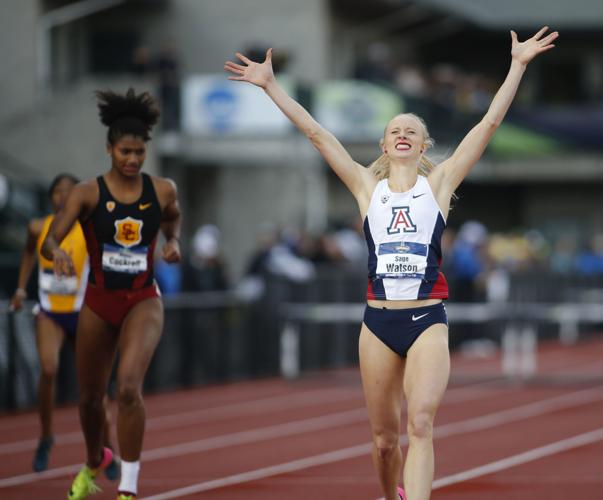
- Greg Hansen
Arizona senior Sage Watson became the 12th UA woman to win an NCAA outdoor track and field championship last week. She won the 400 hurdles in Eugene, Oregon, and becomes, with ex-Wildcat All-American Georgeanne Moline, one of the favorites to reach the 400-meter hurdles at the 2020 Olympics. It’s impressive to research the UA’s list of women’s NCAA champions: Meg Ritchie, Carla Garrett, Amy Skieresz, Tanya Hughes, Brianna Glenn and Brigetta Barrett all won multiple national titles. Barrett, a silver medalist high-jumper at the 2012 London Olympics and three-time NCAA outdoor champ, retired in 2016 to concentrate on a singing and acting career but returned to high jumping in April. She is 26.
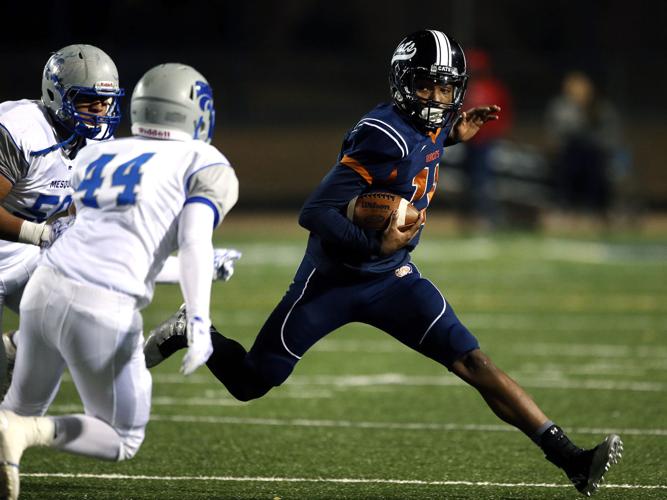
- Greg Hansen
Cienega High senior quarterback Jamarye Joiner has committed to enroll at Arizona in 2018. But last week he attended the ASU Maroon and Gold 7-on-7 passing camp – which his talented Bobcat teammates won – and was offered a scholarship by the Sun Devils. Joiner then posted a twitter photograph wearing ASU gear and flashing the Sun Devils’ pitchfork sign. I get that this is the 21st century and college sports recruiting commitments are often meaningless, but from someone who grew up in an earlier generation – remember the “your word is your bond” pledge? – the flipping and flopping will never sit right. Joiner also got an offer from Pac-12 champion Washington and visited Notre Dame.

- Greg Hansen
The Arizona Coyotes did the right thing by agreeing to stage an NHL preseason game at Tucson Arena against the Anaheim Ducks. The Tucson Roadrunners began their inaugural season, 2016, with limited promotion and marketing time and finished 31st of 32 teams in the American Hockey League in attendance, at just over 4,000 per game. The NHL game, staged on Monday, Sept. 25, should spread the message in Tucson better than any series of promotions.
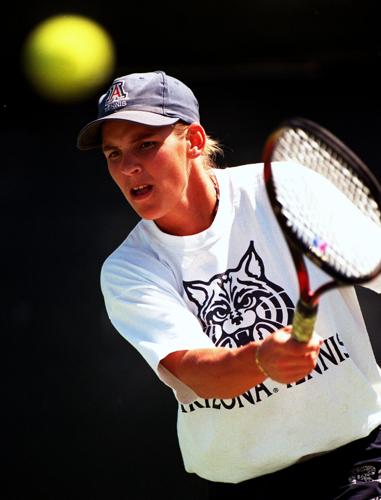
- Greg Hansen
One regrettable omission from my ongoing Top 10 of Everything in Tucson sports series: Vicky Maes, who is probably the top women’s tennis player in UA history, was not part of my list of former UA athletes who became UA head coaches. Big goof. Maes spends the summer as a club pro near Ludington, Michigan.
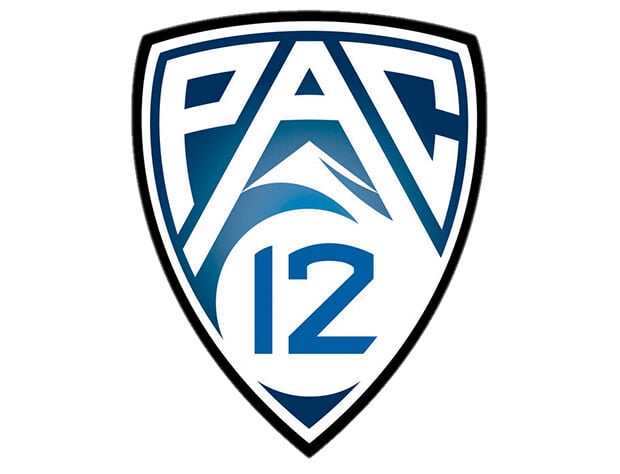
- Greg Hansen
Big Ten commissioner Jim Delaney last week spoke for all college basketball fans by saying his conference is investigating an expansion to 20 league games. Big Ten teams currently play 18 league games – as do the Pac-12, ACC, SEC and Big 12 – which is a sometimes faulty way to determine conference championships. Arizona, for example, will not play at UCLA and USC in 2016-17. That means the UA and others fill the scheduling blanks with schools like CS Bakersfield and Grand Canyon. Delaney told reporters the jump from 18 to 20 conference games “would certainly be favorable to bring more high-profile games to college basketball earlier in the season.” Currently, the MAAC, a league with Iona, Quinnipiac and Niagara, is the only Division I conference to play a 20-game league schedule.
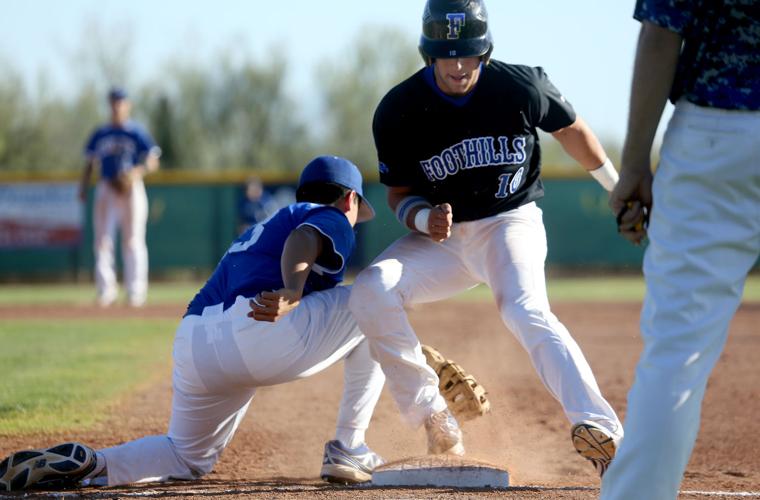
- Greg Hansen
Catalina Foothills outfielder/pitcher Luis Gonzalez and Cienega outfielder/pitcher Andre Jackson were two of Tucson’s leading high school baseball players from 2013-14. Gonzalez went to New Mexico, Jackson to Utah. Both were selected in the MLB draft last week. Gonzalez went No. 87 overall to the White Sox, a spot that pays a bonus of roughly $650,000, and Jackson, who missed the 2017 season at Utah after undergoing Tommy John arm surgery, was taken No. 370 overall by the Dodgers. Jackson could sign for about $100,000, although if the Dodgers like him enough they could offer a maximum of $389,000, which is subject to a fine by MLB.
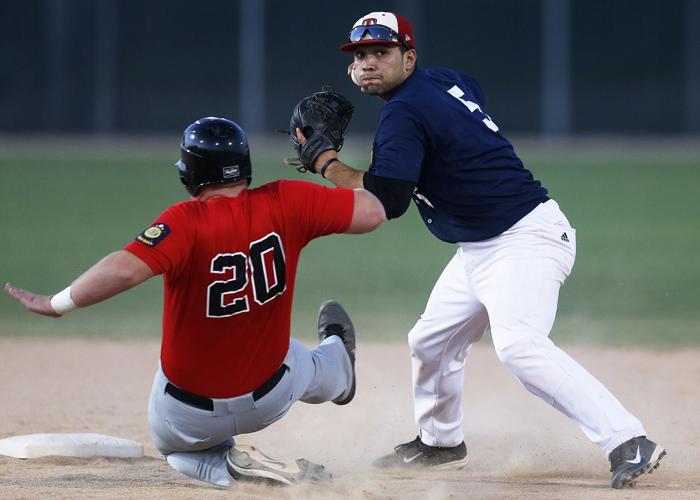
- Greg Hansen
Alex Robles, a Tucson High grad who often played against Gonzalez and Jackson, was drafted in the 30th round by the Minnesota Twins. Robles completed his remarkable career at Austin Peay by hitting a grand slam in his last at-bat. He was a two-time All-Ohio Valley Conference selection who hit a team-high .347 with 10 homers this year. He also won six games as a starting pitcher.
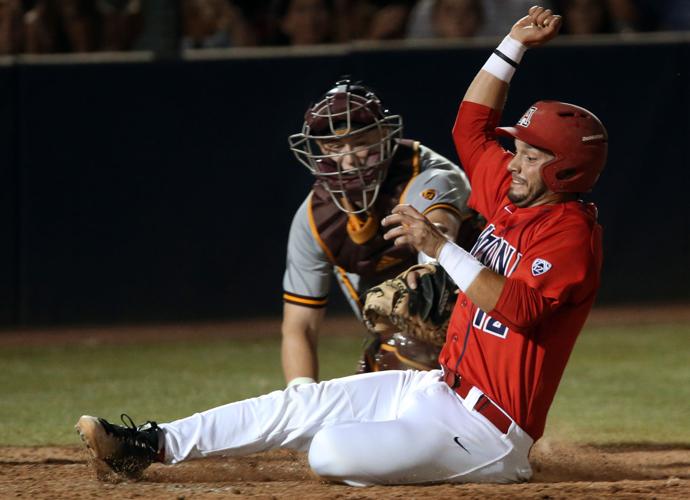
- Greg Hansen
Even though UA sophomore catcher Cesar Salazar wasn’t selected in the MLB draft, I fully believe he’ll play in the big leagues one day. Salazar is a defensive whiz and a clutch hitter. Beyond that, he’s the type of teammate you want in your dugout. Salazar had the game-winning hit against Mississippi State in last year’s Super Regionals. Another edge Salazar has over many catching prospects is that he’s a left-handed hitter.
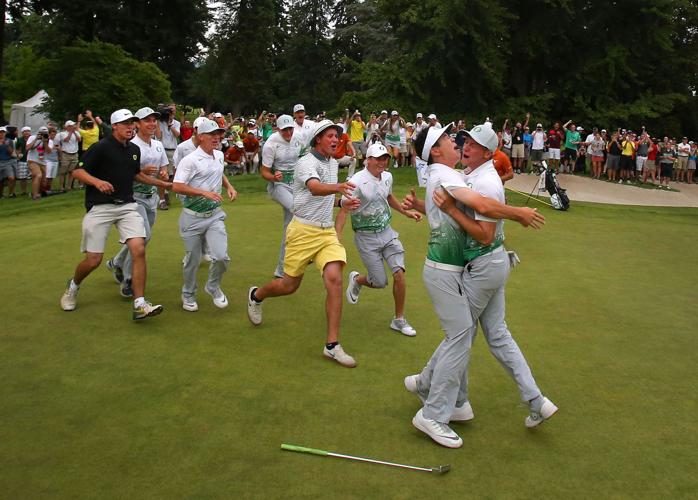
- Greg Hansen
The NCAA blew it last week when it signed a contract to stage the 2020, 2021 and 2022 NCAA men’s and women’s golf championships at the Grayhawk Golf Club in Scottsdale. Did anyone check the history of weather in the final week of May and first week of June in Scottsdale? It’s neither player-friendly nor fan-friendly. Worse, hundreds of volunteers required to operate the NCAA finals will spend eight hours a day in heat near 100 degrees. The NCAA held the 1972 NCAA men’s golf championships at Tucson National and the temperature on the first day was 105 degrees. The Star published a photograph of eventual winner Ben Crenshaw of Texas with future PGA Tour star Lanny Wadkins with the caption “When You’re Hot, You’re Hot.” Golf Channel and the NCAA struck gold when it changed the format of the championship, changing it to a more viewer-friendly team match play format. I suspect the Grayhawk Golf Club paid a small fortune to acquire the rights to be host but it will be an uncomfortable week for all involved.
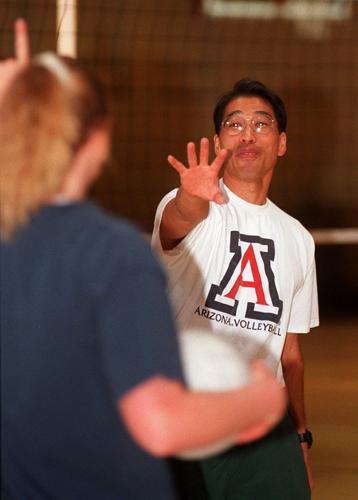
- Greg Hansen
College football coaches aren’t the only coaches to join other programs in summer recruiting camps. Arizona and BYU joined for a weekend at Arizona Stadium recently. UA volleyball coach Dave Rubio was in Sandpoint, Idaho, last week at a recruiting camp in conjunction with Eastern Washington University. Rubio’s recruiting work landed an incoming class ranked as high as No. 12 nationally, with the nation’s Nos. 27, 63 and 86 prospects. The Pac-12 gave Rubio another strange road schedule this week, but rather than a Thursday-Sunday split in the state of Washington, it gave Arizona a back-to-back trip at Colorado and Utah on Nov. 17-18, which is rare.
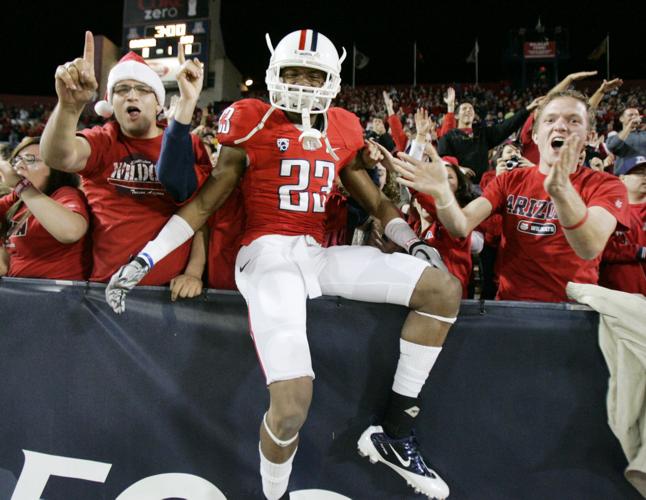
- Greg Hansen
Arizona State announced last week it will not extend football coach Todd Graham’s contract through 2021, which, when a team is winning, is a routine rollover maneuver.
But Graham went 5-7 last year, losing six of his last seven with a defense that yielded 56 points to a bungling Arizona team. Most analysts pick the Sun Devils to battle Arizona for last place in the Pac-12 South.
Arizona has made no announcement on Rich Rodriguez’s contract. It has not been rolled over to 2021, either.
Both schools attempted to trigger some public support last week. Arizona transmitted a photo-shopped twitter image of tailback J.J. Taylor sitting in an tiny chair next to oversized lineman Jacob Alsadek with the theme “Run Game.” After a 3-9 season, the cute summer videos of previous years – a James Bond-themed video and a tough guys at Old Tucson setup – don’t work.
Just play.
ASU last week promoted its new big screen video board at Sun Devil Stadium. It is 5,400 square feet, which is a few yards bigger than the one Greg Byrne installed at Arizona Stadium five years ago.
“Having one of the Top 10 largest video boards in collegiate athletics will set us apart,” said Sun Devil athletics COO Rocky Harris.
Well, probably not. Almost every Pac-12 stadium now has a video screen of similar size and function.



